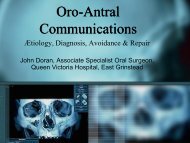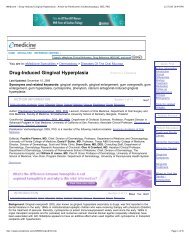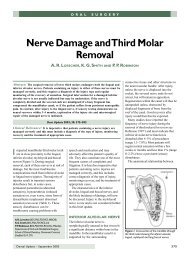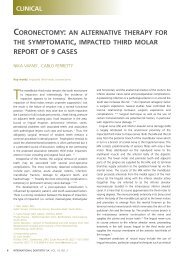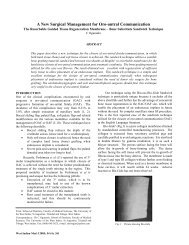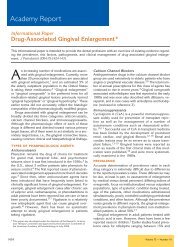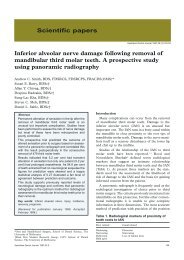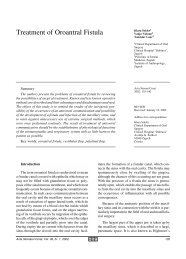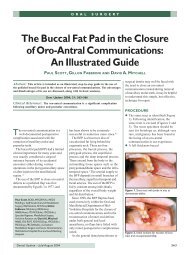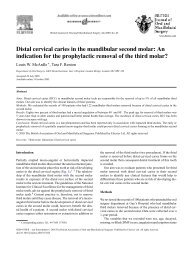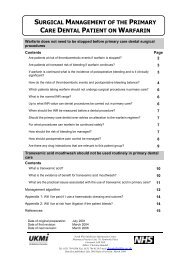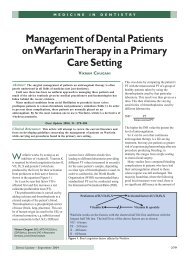Incidence of oral sinus communications in 389 upper third ... - SciELO
Incidence of oral sinus communications in 389 upper third ... - SciELO
Incidence of oral sinus communications in 389 upper third ... - SciELO
You also want an ePaper? Increase the reach of your titles
YUMPU automatically turns print PDFs into web optimized ePapers that Google loves.
Oral Surgery Risk <strong>of</strong> oroantral <strong>communications</strong><br />
<strong>Incidence</strong> <strong>of</strong> <strong>oral</strong> <strong>s<strong>in</strong>us</strong> <strong>communications</strong> <strong>in</strong><br />
<strong>389</strong> <strong>upper</strong> <strong>third</strong> molar extraction<br />
Marta del Rey Santamaría 1 , Eduard Valmaseda Castellón 2 , Leonardo Ber<strong>in</strong>i Aytés 3 , Cosme Gay Escoda 4<br />
(1) Licenciada en Odontología. Máster de Cirugía Bucal e Implantología Buc<strong>of</strong>acial. Facultad de Odontología de la Universidad de Barcelona<br />
(2) Doctor en Odontología. Pr<strong>of</strong>esor Asociado de Cirugía Bucal y Pr<strong>of</strong>esor del Máster de Cirugía Bucal e Implantología Buc<strong>of</strong>acial.<br />
Facultad de Odontología de la Universidad de Barcelona<br />
(3) Pr<strong>of</strong>esor Titular de Patología Quirúrgica Bucal y Maxil<strong>of</strong>acial. Pr<strong>of</strong>esor del Máster de Cirugía Bucal e Implantología Buc<strong>of</strong>acial.<br />
Facultad de Odontología de la Universidad de Barcelona<br />
(4) Catedrático de Patología Quirúrgica Bucal y Maxil<strong>of</strong>acial. Director del Máster de Cirugía Bucal e Implantología Buc<strong>of</strong>acial. Facultad<br />
de Odontología de la Universidad de Barcelona. Cirujano Maxil<strong>of</strong>acial del Centro Médico Teknon (Barcelona)<br />
Correspondence:<br />
Dr. Cosme Gay Escoda<br />
Centro Médico Teknon<br />
C/ Vilana, 12.<br />
08022 Barcelona<br />
E-mail:cgay@ub.edu<br />
Received: 12-03-2005<br />
Accepted: 12-02-2006<br />
del Rey-Santamaría M, Valmaseda-Castellón E, Ber<strong>in</strong>i-Aytés L, Gay-Escoda<br />
C. <strong>Incidence</strong> <strong>of</strong> <strong>oral</strong> <strong>s<strong>in</strong>us</strong> <strong>communications</strong> <strong>in</strong> <strong>389</strong> <strong>upper</strong> thirmolar<br />
extraction. Med Oral Patol Oral Cir Bucal 2006;11:E334-8.<br />
© Medic<strong>in</strong>a Oral S. L. C.I.F. B 96689336 - ISSN 1698-6946<br />
Indexed <strong>in</strong>:<br />
-Index Medicus / MEDLINE / PubMed<br />
-EMBASE, Excerpta Medica<br />
-Indice Médico Español<br />
-IBECS<br />
Click here to view the<br />
article <strong>in</strong> Spanish<br />
ABSTRACT<br />
Introduction. The <strong>in</strong>cidence <strong>of</strong> <strong>oral</strong> <strong>s<strong>in</strong>us</strong> <strong>communications</strong> (OSC) follow<strong>in</strong>g the extraction <strong>of</strong> an <strong>upper</strong> <strong>third</strong> molar rema<strong>in</strong>s<br />
uncerta<strong>in</strong>.<br />
Objectives. The purpose <strong>of</strong> this study was to determ<strong>in</strong>e the <strong>in</strong>cidence <strong>of</strong> OSC follow<strong>in</strong>g the extraction <strong>of</strong> <strong>389</strong> consecutive<br />
<strong>upper</strong> <strong>third</strong> molars dur<strong>in</strong>g 2003 <strong>in</strong> the Master <strong>of</strong> Oral Surgery and Or<strong>of</strong>acial Implantology (Barcelona University,<br />
Spa<strong>in</strong>).<br />
Patients and method. Different variables were recorded, <strong>in</strong>clud<strong>in</strong>g patient age, sex, molar angulation, surgical technique<br />
and radiological <strong>s<strong>in</strong>us</strong> proximity, to determ<strong>in</strong>e the relation between <strong>third</strong> molar extraction and the <strong>in</strong>cidence <strong>of</strong> OSC.<br />
Results. Only 5.1% (95% CI: 2.2-7.3%) <strong>of</strong> the <strong>upper</strong> molar surgical extractions produced OSC, the risk <strong>of</strong> which was<br />
found to be similar <strong>in</strong> all age groups and <strong>in</strong>creased with the depth <strong>of</strong> <strong>third</strong> molar <strong>in</strong>clusion, the complexity <strong>of</strong> the surgical<br />
technique and the performance <strong>of</strong> an ostectomy.<br />
Key words: Oral <strong>s<strong>in</strong>us</strong> <strong>communications</strong>, <strong>in</strong>cidence, <strong>third</strong> molar, tooth extraction.<br />
RESUMEN<br />
Introducción. La <strong>in</strong>cidencia de las comunicaciones buco<strong>s<strong>in</strong>us</strong>ales (CBS) tras la extracción del tercer molar superior no<br />
se conoce con exactitud.<br />
Objetivos. El objetivo de este estudio fue identificar la <strong>in</strong>cidencia de las CBS tras la extracción de <strong>389</strong> cordales superiores<br />
realizadas durante el año 2003 en el Máster de Cirugía Bucal e Implantología Buc<strong>of</strong>acial de la Universidad de<br />
Barcelona.<br />
Material y método. Se registraron diversas variables con el f<strong>in</strong> de determ<strong>in</strong>ar la relación de la extracción del tercer molar<br />
con la <strong>in</strong>cidencia de las CBS: la edad y el sexo del paciente, la angulación del cordal, la técnica quirúrgica y la sospecha<br />
radiológica de proximidad con el seno maxilar.<br />
Resultados. Únicamente el 5.1% (IC 95%: 2.2-7.3%) de las extracciones quirúrgicas de los cordales superiores provocaron<br />
una CBS. El riesgo de producir una CBS fue similar en todos los grupos de edad, y aumentó con la pr<strong>of</strong>undidad de<br />
<strong>in</strong>clusión del tercer molar, la complejidad de la técnica quirúrgica y al efectuar ostectomía.<br />
Palabras clave: Comunicación buco<strong>s<strong>in</strong>us</strong>al, <strong>in</strong>cidencia, tercer molar, extracción dentaria.<br />
© Medic<strong>in</strong>a Oral S.L. Email: medic<strong>in</strong>a@medic<strong>in</strong>a<strong>oral</strong>.com<br />
E334
Med Oral Patol Oral Cir Bucal 2006;11:E334-8. Risk <strong>of</strong> oroantral <strong>communications</strong><br />
INTRODUCTION<br />
Oral <strong>s<strong>in</strong>us</strong> <strong>communications</strong> (OSC) are pathological conditions<br />
characterized by the existence <strong>of</strong> a communication<br />
between the <strong>oral</strong> cavity and the maxillary <strong>s<strong>in</strong>us</strong>, as the result<br />
<strong>of</strong> a loss <strong>of</strong> the s<strong>of</strong>t and hard tissues which normally separate<br />
both compartments (1). OSC are a complication <strong>of</strong> dental<br />
extractions that facilitate microbial contam<strong>in</strong>ation from the<br />
<strong>oral</strong> cavity towards the <strong>in</strong>terior <strong>of</strong> the maxillary <strong>s<strong>in</strong>us</strong> (2). If<br />
the OSC rema<strong>in</strong>s open to the buccal space, or if <strong>in</strong>fection<br />
persists for a long period <strong>of</strong> time, chronic <strong>in</strong>flammation<br />
<strong>of</strong> the <strong>s<strong>in</strong>us</strong>al membrane may result (3,4), with permanent<br />
epithelization <strong>of</strong> the <strong>oral</strong> <strong>s<strong>in</strong>us</strong> fistula – a situation that<br />
further <strong>in</strong>creases the risk <strong>of</strong> <strong>s<strong>in</strong>us</strong>itis (5-7). In recent OSC,<br />
the marg<strong>in</strong>s are seen to be edematous, as a result <strong>of</strong> which<br />
spontaneous heal<strong>in</strong>g depends only on the existence <strong>of</strong><br />
normal, stable and un<strong>in</strong>fected clott<strong>in</strong>g, and the capacity to<br />
cover the clot with ciliary epithelium <strong>of</strong> the maxillary <strong>s<strong>in</strong>us</strong><br />
and squamous epithelium <strong>of</strong> the <strong>oral</strong> cavity (4-6).<br />
The most frequent cause underly<strong>in</strong>g OSC is surgical extraction<br />
<strong>of</strong> the second premolar and <strong>of</strong> the first and second<br />
molars <strong>of</strong> the <strong>upper</strong> jaw (the latter also be<strong>in</strong>g referred to<br />
as “antral teeth”) (2,6,8,9). This is due to the proximity<br />
between the apexes <strong>of</strong> these teeth and the maxillary <strong>s<strong>in</strong>us</strong><br />
(2,5,6,10,11), with a distance <strong>of</strong> 1-7 mm (5), or to root protrusion<br />
<strong>in</strong>to the floor <strong>of</strong> the maxillary <strong>s<strong>in</strong>us</strong> secondary to<br />
important pneumatization <strong>of</strong> the latter (11). The thickness<br />
<strong>of</strong> the lateral walls <strong>of</strong> the maxillary <strong>s<strong>in</strong>us</strong> is not uniform and<br />
varies between 2-3 mm <strong>in</strong> the region <strong>of</strong> the <strong>s<strong>in</strong>us</strong> floor (8). In<br />
a study published by Killey and Kay (cited by Punwutikorn<br />
et al. (10)) <strong>in</strong>volv<strong>in</strong>g 250 patients, more than half <strong>of</strong> the OSC<br />
occurred after extraction <strong>of</strong> the first molar, and approximately<br />
25% as a result <strong>of</strong> second molar extraction. The<br />
complication may also arise <strong>in</strong> the case <strong>of</strong> <strong>upper</strong> <strong>third</strong> molar<br />
extractions, when perform<strong>in</strong>g an aggressive surgical technique,<br />
excessive post-extraction alveolar curettage, or when<br />
the patient <strong>in</strong> the immediate postoperative period performs<br />
maneuvers that tend to <strong>in</strong>crease <strong>in</strong>tra<strong>s<strong>in</strong>us</strong> pressure (1,6).<br />
Other factors may also contribute to produce perforation <strong>of</strong><br />
the <strong>s<strong>in</strong>us</strong> membrane and OSC, such as traumatisms, other<br />
dental extractions, implant surgery and radiotherapy <strong>of</strong> the<br />
head and neck. Other contribut<strong>in</strong>g conditions <strong>in</strong>clude <strong>in</strong>fectious<br />
and <strong>in</strong>flammatory processes <strong>of</strong> the <strong>upper</strong> jaw, cysts<br />
develop<strong>in</strong>g from the mucosa <strong>of</strong> the maxillary <strong>s<strong>in</strong>us</strong>, benign<br />
or malignant <strong>s<strong>in</strong>us</strong>al neoplasms, and specific <strong>in</strong>fections such<br />
as syphilis or tuberculosis (4,6,12-14).<br />
The <strong>in</strong>cidence <strong>of</strong> OSC <strong>in</strong> patients subjected to <strong>upper</strong> <strong>third</strong><br />
molar extraction is not clear, and the patients at greatest<br />
risk <strong>of</strong> develop<strong>in</strong>g this complication rema<strong>in</strong> to be def<strong>in</strong>ed.<br />
The present study thus attempts to determ<strong>in</strong>e the <strong>in</strong>cidence<br />
<strong>of</strong> OSC follow<strong>in</strong>g <strong>upper</strong> <strong>third</strong> molar extraction <strong>in</strong> an Oral<br />
Surgery Unit, and def<strong>in</strong>e the course <strong>of</strong> the complication<br />
and the pre- and <strong>in</strong>traoperative factors associated with the<br />
appearance <strong>of</strong> OSC.<br />
PATIENTS AND METHOD<br />
The data correspond<strong>in</strong>g to <strong>389</strong> <strong>upper</strong> <strong>third</strong> molar extractions<br />
(353 surgical and 36 conventional) performed dur<strong>in</strong>g 2003<br />
<strong>in</strong> the Oral Surgery Unit <strong>of</strong> the Master <strong>of</strong> Oral Surgery and<br />
Or<strong>of</strong>acial Implantology (Barcelona University, Spa<strong>in</strong>) were<br />
documented. Before the <strong>in</strong>tervention and on the visit after<br />
7 days to remove the sutures, the follow<strong>in</strong>g variables were<br />
recorded: patient age and sex, <strong>third</strong> molar angulation, radiological<br />
<strong>s<strong>in</strong>us</strong> proximity, the surgical technique employed<br />
(conventional extraction, with the rais<strong>in</strong>g <strong>of</strong> a flap, or with<br />
the rais<strong>in</strong>g <strong>of</strong> a flap and ostectomy), the existence <strong>of</strong> postextraction<br />
OSC, and the cause underly<strong>in</strong>g the latter.<br />
Third molar angulation was established based on the W<strong>in</strong>ter<br />
classification, which relates the <strong>third</strong> molar to the longitud<strong>in</strong>al<br />
axis <strong>of</strong> the second molar (mesioangular, horizontal,<br />
vertical, distoangular or <strong>in</strong>verted) (1).<br />
Follow<strong>in</strong>g <strong>in</strong>filtration anesthesia with 4% artica<strong>in</strong>e and<br />
adrenal<strong>in</strong>e (1:100,000), a crestal <strong>in</strong>cision, distal to the second<br />
molar, and a vertical releas<strong>in</strong>g <strong>in</strong>cision were made, and a<br />
mucoperiosteal flap was raised. The bone was removed<br />
where necessary, us<strong>in</strong>g a handpiece and rounded number<br />
8 tungsten carbide drill, with luxation and avulsion <strong>of</strong> the<br />
<strong>third</strong> molar us<strong>in</strong>g straight and Pott elevators. At the time<br />
<strong>of</strong> the <strong>in</strong>tervention, and based on the Valsalva maneuver,<br />
the presence or absence <strong>of</strong> OSC was determ<strong>in</strong>ed. The result<br />
was def<strong>in</strong>ed as positive <strong>in</strong> the event <strong>of</strong> <strong>in</strong>traalveolar bubbl<strong>in</strong>g<br />
when the patient attempted to expel air through the plugged<br />
nose. Alveolar clean<strong>in</strong>g and curettage was subsequently<br />
carried out, avoid<strong>in</strong>g <strong>in</strong> depth maneuver<strong>in</strong>g and irrigat<strong>in</strong>g<br />
with sterile physiological sal<strong>in</strong>e solution. The surgical wound<br />
was f<strong>in</strong>ally sutured us<strong>in</strong>g simple 3/0 silk stitches.<br />
After the operation, an antibiotic was prescribed (amoxicill<strong>in</strong><br />
750 mg/8 hours p.o. for 7 days), together with an<br />
anti<strong>in</strong>flammatory agent (sodium dicl<strong>of</strong>enac 50 mg/8 hours<br />
p.o. for 3 days) and a mouthr<strong>in</strong>se (0.12% chlorhexid<strong>in</strong>e<br />
digluconate every 12 hours for 10-15 days). All smokers<br />
were <strong>in</strong>structed to avoid smok<strong>in</strong>g <strong>in</strong> the first 8 days after the<br />
<strong>in</strong>tervention. The patients diagnosed <strong>of</strong> OSC were advised to<br />
avoid <strong>in</strong>tranasal pressure-<strong>in</strong>creas<strong>in</strong>g maneuvers dur<strong>in</strong>g the<br />
postoperative period (Valsalva maneuver, gargles, repeated<br />
suction<strong>in</strong>g, etc.).<br />
The data obta<strong>in</strong>ed were processed and analyzed with the<br />
SPSS 9.0 statistical package. Statistical significance was assessed<br />
with the Pearson chi-square test. The nonparametric<br />
Mann-Whitney U-test was <strong>in</strong> turn used to correlate patient<br />
age to <strong>in</strong>traoperative OSC.<br />
RESULTS<br />
Only 20 OSC were identified dur<strong>in</strong>g surgical extraction <strong>of</strong><br />
the 353 <strong>upper</strong> <strong>third</strong> molars, while none <strong>of</strong> the 36 molars<br />
subjected to conventional extraction were associated with<br />
OSC. This corresponded to a 5.1% risk <strong>of</strong> OSC (95% confidence<br />
<strong>in</strong>terval (95% CI): 2.2-7.3%). In most cases (n = 18/20)<br />
OSC occurred after luxat<strong>in</strong>g the tooth with<strong>in</strong> the alveolar<br />
cavity. In only one case was perforation directly caused<br />
by the elevator, while <strong>in</strong> another case the tooth itself was<br />
impelled <strong>in</strong>to the maxillary <strong>s<strong>in</strong>us</strong> as a result <strong>of</strong> the luxation<br />
maneuvers. This molar was subsequently retrieved adopt<strong>in</strong>g<br />
E335<br />
© Medic<strong>in</strong>a Oral S.L. Email: medic<strong>in</strong>a@medic<strong>in</strong>a<strong>oral</strong>.com
Oral Surgery Risk <strong>of</strong> oroantral <strong>communications</strong><br />
a Caldwell-Luc approach. Eighty-five percent <strong>of</strong> all OSC<br />
were observed <strong>in</strong> women (17 cases), correspond<strong>in</strong>g to 4.4%<br />
<strong>of</strong> the total.The risk <strong>in</strong> female was 2’4 times greater than<br />
male, though the difference between sexes was nonsignificant<br />
(X 2 = 2.213; df = 1; p = 0.137). The median patient age<br />
was 21 years. The risk <strong>of</strong> OSC did not differ significantly<br />
among the different age groups (Mann-Whitney U-test =<br />
3337; p = 0.470). The risk oscillated between 4’8% <strong>in</strong> the<br />
group <strong>of</strong> patients older than 40 years and 5’3% <strong>in</strong> the group<br />
<strong>of</strong> patients between 20 and 39 years old. The relative risk<br />
<strong>of</strong> OSC doubled when an ostectomy was performed dur<strong>in</strong>g<br />
surgery, though the chi-square test proved nonsignificant<br />
(X 2 = 2.385; df = 1; p = 0.123)(Table 1).<br />
Table 1. Relation between the occurrence <strong>of</strong> <strong>in</strong>traoperative OSC and<br />
the surgical technique performed for <strong>upper</strong> <strong>third</strong> molar extraction. The<br />
risk <strong>of</strong> OSC is seen to <strong>in</strong>crease with the complication <strong>of</strong> molar extraction,<br />
though the l<strong>in</strong>ear-trend chi-square test failed to reach statistical<br />
significance (X LT<br />
2<br />
= 3.411; df = 2; p = 0.065).<br />
Conventional<br />
extraction<br />
Surgical<br />
extraction<br />
without<br />
ostectomy<br />
Surgical<br />
extraction<br />
with<br />
ostectomy<br />
Total<br />
OSC 0 7 13 20<br />
No<br />
OSC<br />
36 159 174 369<br />
Total 36 166 187 <strong>389</strong><br />
Risk 0% 4.2% 7.0%<br />
Of the global OSC recorded, one-half corresponded to<br />
the left side and the other half to the right. No relation<br />
was observed between the surgical side and the occurrence<br />
<strong>of</strong> <strong>in</strong>traoperative OSC (X 2 = 0; df = 1; p = 0.991). In only<br />
7 (35%) <strong>of</strong> the global 20 cases <strong>of</strong> OSC, the surgeon don’t<br />
suspect a close relation between the <strong>third</strong> molar roots and<br />
the maxillary <strong>s<strong>in</strong>us</strong>, based on the orthopantomographic<br />
f<strong>in</strong>d<strong>in</strong>gs. The risk <strong>of</strong> OSC was seen to <strong>in</strong>crease with the<br />
surgical complexity <strong>of</strong> extraction, though the l<strong>in</strong>ear-trend<br />
chi-square test failed to reach statistical significance (X LT<br />
2<br />
=<br />
3.411; df = 2; p = 0.065)(Table 1). Of the 20 OSC produced,<br />
none presented a permanent fistulous trajectory dur<strong>in</strong>g the<br />
control at 7 days after the <strong>in</strong>tervention. In all cases OSC was<br />
sealed by fill<strong>in</strong>g the alveolar space with textured collagen<br />
and perform<strong>in</strong>g flap suture.<br />
DISCUSSION<br />
The results obta<strong>in</strong>ed <strong>in</strong> the present study show most patients<br />
subjected to <strong>third</strong> molar extraction to be women (70.2%), as<br />
a result <strong>of</strong> which <strong>oral</strong> <strong>s<strong>in</strong>us</strong> communication (OSC) was more<br />
frequent <strong>in</strong> this sex (85%). The difference between sexes failed<br />
to reach statistical significance, however. The relative risk<br />
(RR) male:female is 2’4, this means that women have 2’4 times<br />
OSC than men, <strong>in</strong> co<strong>in</strong>cidence with the observations <strong>of</strong> other<br />
authors (2,10,15). Nevertheless, Amaratunga (16) reported a<br />
greater frequency <strong>of</strong> OSC <strong>in</strong> males – attribut<strong>in</strong>g this observation<br />
to a more frequent <strong>in</strong>dication <strong>of</strong> <strong>third</strong> molar extraction<br />
and <strong>in</strong>creased technical difficulties than <strong>in</strong> women.<br />
We observed no significant differences between patient age at<br />
the time <strong>of</strong> <strong>upper</strong> <strong>third</strong> molar extraction and the occurrence<br />
<strong>of</strong> OSC, though accord<strong>in</strong>g to Punwutikorn et al. (10), the<br />
<strong>in</strong>cidence <strong>of</strong> OSC is greater <strong>in</strong> the 60-69 years age group.<br />
Other authors <strong>in</strong> turn refer a greater number <strong>of</strong> OSC and<br />
fistulas <strong>in</strong> the <strong>third</strong> (2,5,15,16), fourth and fifth decades <strong>of</strong><br />
life (17), together with a very low or negligible <strong>in</strong>cidence <strong>of</strong><br />
the complication <strong>in</strong> childhood (2,10,16). In this context, it<br />
should be mentioned that many <strong>of</strong> these studies (2,10,16,17)<br />
<strong>in</strong>clude the extraction <strong>of</strong> other teeth (e.g., molars or premolars)<br />
with a closer relation to the maxillary <strong>s<strong>in</strong>us</strong>.<br />
21% <strong>of</strong> <strong>upper</strong> <strong>third</strong> molars have a partial bone retention<br />
but did not need ostectomy as we can see <strong>in</strong> table 2 and 3.<br />
The bone <strong>of</strong> the <strong>upper</strong> maxillary tuberosity is <strong>of</strong> a s<strong>of</strong>ter<br />
consistency than <strong>in</strong> the lower jaw – a fact that allows direct<br />
<strong>third</strong> molar luxation and avulsion us<strong>in</strong>g straight and Pott<br />
elevators, with the need <strong>in</strong> many cases <strong>of</strong> an ostectomy.<br />
Only based <strong>in</strong> the orthopantomograph, is posible to make<br />
a mistake <strong>in</strong> the diagnostic <strong>of</strong> surgical difficulty.<br />
Table 2. Relation between the occurrence <strong>of</strong> <strong>in</strong>traoperative OSC and<br />
the need for ostectomy dur<strong>in</strong>g <strong>upper</strong> <strong>third</strong> molar extraction.<br />
No ostectomy Ostectomy Total<br />
OSC 7 (35%) 13 (65%) 20 (100%)<br />
No OSC 197 (53%) 171 (46.5%) 368 (100%)<br />
Total 204 (52.6%) 184 (47.4%) 388 (100%)<br />
Risk 0.034 (3.4%) 0.071 (7.1%)<br />
Table 3. Relation between the occurrence <strong>of</strong> <strong>in</strong>traoperative OSC and the<br />
<strong>in</strong>clusion degree <strong>of</strong> <strong>upper</strong> <strong>third</strong> molar.<br />
Submucosa<br />
<strong>in</strong>clusion<br />
Parcial o<br />
total<br />
Intraoseus<br />
<strong>in</strong>clusion<br />
No<br />
<strong>in</strong>clusion<br />
Total<br />
OSC 3 (15%) 16 (80%) 1 (5%) 20 (100%)<br />
No OSC 84 (22.8%) 250 (67.8%) 35 (9.5%) 369 (100%)<br />
Total 87 (22.4%) 266 (68.4%) 36 (9.3%) <strong>389</strong> (100%)<br />
OSC was found to be as frequent on the left side as on the<br />
right, <strong>in</strong> agreement with the observations <strong>of</strong> Punwutikorn et<br />
al. (10). As regards the cause underly<strong>in</strong>g OSC, our observations<br />
are <strong>in</strong> l<strong>in</strong>e with those published by other <strong>in</strong>vestigators,<br />
accord<strong>in</strong>g to whom actual dental extraction is the most<br />
frequent cause (1,2,4,5,10). In comparison, the existence<br />
<strong>of</strong> cysts, iatrogenic effects attributable to poor use <strong>of</strong> the<br />
surgical material, or the penetration <strong>of</strong> roots and even<br />
complete teeth <strong>in</strong>to the maxillary <strong>s<strong>in</strong>us</strong> are considered to<br />
be only m<strong>in</strong>or causes (6,9,18).<br />
E336<br />
© Medic<strong>in</strong>a Oral S.L. Email: medic<strong>in</strong>a@medic<strong>in</strong>a<strong>oral</strong>.com
Med Oral Patol Oral Cir Bucal 2006;11:E334-8. Risk <strong>of</strong> oroantral <strong>communications</strong><br />
Our study did not take <strong>in</strong>to account the reason for <strong>upper</strong><br />
<strong>third</strong> molar extraction – a factor that could be <strong>of</strong> importance<br />
<strong>in</strong> predict<strong>in</strong>g the risk <strong>of</strong> OSC. In some cases a periapical<br />
lesion may weaken the th<strong>in</strong> bone lam<strong>in</strong>a separat<strong>in</strong>g the maxillary<br />
<strong>s<strong>in</strong>us</strong> from the alveolar space (10,13). In any case we<br />
don´t evidenced cl<strong>in</strong>ical or s<strong>in</strong>tomatology who made suspect<br />
a fistulous trajectory presence from the maxillary <strong>s<strong>in</strong>us</strong> to<br />
the <strong>oral</strong> cavity. Is possible that 7 days after extraction is not<br />
enough to assure the absence <strong>of</strong> fistulous trajectory, but is<br />
no necessary more controls <strong>in</strong> a patient without cl<strong>in</strong>ical and<br />
s<strong>in</strong>tomatology. All cases develops favourable.<br />
It would have been <strong>in</strong>terest<strong>in</strong>g to measure the size <strong>of</strong> the<br />
bone defects result<strong>in</strong>g from surgical extraction, s<strong>in</strong>ce accord<strong>in</strong>g<br />
to some authors gaps measur<strong>in</strong>g over 5 mm <strong>in</strong><br />
diameter are unlikely to undergo spontaneous primary<br />
closure (9-11,19,20). Kretzschmar and cols. (11) limited the<br />
spontaneous primary closure to 2 mm <strong>in</strong> diameter, over this<br />
size we need to suture the maxillary <strong>s<strong>in</strong>us</strong> membrane and<br />
if this is not possible to make a palat<strong>in</strong> flap. However, due<br />
to the limited visibility <strong>of</strong> the surgical field it is not always<br />
possible to precisely determ<strong>in</strong>e the size <strong>of</strong> the result<strong>in</strong>g<br />
OSC. In our series the alveolar space was always filled with<br />
textured collagen, attempt<strong>in</strong>g to achieve primary mucosal<br />
closure – thereby mak<strong>in</strong>g it easier for OSC to heal by first<br />
<strong>in</strong>tention, without the need for sutur<strong>in</strong>g the maxillary <strong>s<strong>in</strong>us</strong><br />
membrane. 39% <strong>of</strong> the OSC presenced <strong>in</strong> tha Hirata<br />
and cols. (15) study undergo spontaneous primary closure<br />
dur<strong>in</strong>g postoperative controls and 56% needed sterile physiological<br />
sal<strong>in</strong>e solution irrigation. In the series published<br />
by Ehrl (17), 51% <strong>of</strong> the OSC with signs and symptoms <strong>of</strong><br />
<strong>s<strong>in</strong>us</strong>itis and subjected to conservative management were<br />
not successfully resolved.<br />
The <strong>in</strong>traoperative diagnosis <strong>of</strong> OSC is usually based on<br />
the Valsalva maneuver (6,11,12), which <strong>of</strong>fers a sensitivity<br />
<strong>of</strong> 52% (17). Penetration <strong>of</strong> a blunt-edged Bowman probe<br />
to assess perforations <strong>of</strong> the maxillary <strong>s<strong>in</strong>us</strong> floor is also<br />
valid for diagnos<strong>in</strong>g OSC (6,12), with a sensitivity <strong>of</strong> 98%<br />
(17). A limitation <strong>in</strong> our study is represented by the fact<br />
that the diagnosis <strong>of</strong> OSC was based only on performance<br />
<strong>of</strong> the Valsalva maneuver. If <strong>in</strong> addition to the latter other<br />
methods such as visual <strong>in</strong>spection, alveolar palpation and<br />
a Bowman probe had been used, a higher sensitivity would<br />
probably have been achieved.<br />
In the case we can foresee a OSC, Kretzschmar and cols.<br />
(11) recomended an antibiotic treatment dur<strong>in</strong>g 10 days as<br />
a prophylactic measure to avoid a bacterial rh<strong>in</strong>o<strong>s<strong>in</strong>us</strong>itis.<br />
However Walton (21) is not agree with this obsevation<br />
and he do not need necessary antibiotic adm<strong>in</strong>istration <strong>in</strong><br />
<strong>s<strong>in</strong>us</strong> exposition cases because <strong>of</strong> the presence <strong>of</strong> penicil<strong>in</strong><br />
resistances baterias.<br />
Although periapical X-rays can be useful for diagnos<strong>in</strong>g<br />
OSC, the usual approach is to employ extra<strong>oral</strong> projections<br />
(e.g., orthopantomography and the Waters projection) which<br />
can visualize the <strong>oral</strong> cavity, the maxillary <strong>s<strong>in</strong>us</strong> and the<br />
trajectory <strong>of</strong> the communication. However, <strong>in</strong> well established<br />
OSC, fistulography and transalveolar endoscopy afford<br />
more <strong>in</strong>formation regard<strong>in</strong>g the size <strong>of</strong> the perforation, its<br />
anatomical relations, and the fistulous trajectory. Computed<br />
axial tomography <strong>in</strong> turn can assess the size <strong>of</strong> the fistula,<br />
the characteristics <strong>of</strong> the bone and mucosa surround<strong>in</strong>g<br />
the perforation, and the nature <strong>of</strong> the <strong>s<strong>in</strong>us</strong> mucosal lesion<br />
(1,4,6,12,22,23). Nevertheless, computed axial tomography<br />
has certa<strong>in</strong> limitations and is unable to detect f<strong>in</strong>e bone<br />
lam<strong>in</strong>as – as a result <strong>of</strong> which the diameter <strong>of</strong> the fistula<br />
may be overestimated.<br />
When the radiological study conducted prior to extraction<br />
suggests a risk <strong>of</strong> OSC, the Ries-Centeno technique can<br />
be performed, <strong>in</strong>volv<strong>in</strong>g the rais<strong>in</strong>g <strong>of</strong> a mucoperiosteal<br />
vestibular flap before extraction, and cover<strong>in</strong>g the defect<br />
by rotat<strong>in</strong>g and sutur<strong>in</strong>g the flap once extraction has been<br />
completed (6,13). In the event OSC occurs dur<strong>in</strong>g extraction,<br />
it is always advisable to achieve primary closure; as<br />
a result, dur<strong>in</strong>g surgery the alveolar space should be filled<br />
with reabsorbable hemostatic material, jo<strong>in</strong><strong>in</strong>g the g<strong>in</strong>gival<br />
marg<strong>in</strong>s with suture (1,2,6). If sufficient g<strong>in</strong>gival tissue is<br />
available, an alveoloplasty is performed to reduce the bone<br />
height and ensure seal<strong>in</strong>g <strong>of</strong> the communication with sutur<strong>in</strong>g<br />
<strong>of</strong> the g<strong>in</strong>gival marg<strong>in</strong>s (1,6,7). Kitagawa and cols.<br />
(20) reported 2 cases <strong>of</strong> OSC produced dur<strong>in</strong>g an <strong>upper</strong><br />
first molar extracction that were closed succesfully by the<br />
transplantation <strong>of</strong> a <strong>third</strong> molar with the apex closed.<br />
The root canal treatment <strong>of</strong> the transplanted theeth was<br />
made 3 weeks after. The prosthetic treatment was made at<br />
5 months. In both cases the controls were made at 2 and 3<br />
years respectively. Whith this procedure, the OSC is closed<br />
and masticatory function is established <strong>in</strong>mediately. When<br />
the OSC persists for more than three weeks, the fistulous<br />
trajectory between the maxillary <strong>s<strong>in</strong>us</strong> and <strong>oral</strong> cavity beg<strong>in</strong>s<br />
to undergo epithelization – thereby preclud<strong>in</strong>g spontaneous<br />
closure (18). In order to allow cicatrization and closure <strong>of</strong><br />
the defect, flaps compris<strong>in</strong>g the tissues adjacent to the OSC<br />
should be employed wherever possible. Additional measures<br />
<strong>in</strong>clude a meticulous surgical technique with good asepsis<br />
(6) and optimum patient cooperation after the <strong>in</strong>tervention.<br />
Our postoperative recommendations, such as the provision<br />
<strong>of</strong> a liquid diet, the prescription <strong>of</strong> adequate pharmacological<br />
treatment, avoidance <strong>of</strong> the Valsalva maneuver, and<br />
the suppression <strong>of</strong> smok<strong>in</strong>g, all co<strong>in</strong>cide with the recommendations<br />
<strong>of</strong> other authors (1,6,11,12), and may account<br />
for the low <strong>in</strong>cidence <strong>of</strong> OSC observed.<br />
CONCLUSIONS<br />
1.- Only 5.1% (95% CI: 2.2-7.3%) <strong>of</strong> the surgical extractions<br />
<strong>of</strong> <strong>upper</strong> <strong>third</strong> molars produced <strong>in</strong>traoperative OSC.<br />
2.- The risk <strong>of</strong> <strong>in</strong>traoperative OSC was similar <strong>in</strong> all age<br />
groups.<br />
3.- In all cases <strong>of</strong> OSC cl<strong>in</strong>ical and s<strong>in</strong>tomatology absence<br />
was checked dur<strong>in</strong>g the control 7 days after the <strong>in</strong>tervention,<br />
before fill<strong>in</strong>g the alveolar space with textured collagen and<br />
perform<strong>in</strong>g flap suture.<br />
º<br />
E337<br />
© Medic<strong>in</strong>a Oral S.L. Email: medic<strong>in</strong>a@medic<strong>in</strong>a<strong>oral</strong>.com
Oral Surgery Risk <strong>of</strong> oroantral <strong>communications</strong><br />
REFERENCES<br />
1. Gay Escoda C, Ber<strong>in</strong>i Aytés L. Cirugía bucal. Barcelona: Ergon; 1999.<br />
p. 317-52, 831-78.<br />
2. Güven O. A cl<strong>in</strong>ical study on oroantral fistulae. J Cranio-Maxill<strong>of</strong>ac<br />
Surg 1998;26:267-71.<br />
3. Car M, Juretic M. Treatment <strong>of</strong> oroantral <strong>communications</strong> after tooth<br />
extractions. Is dra<strong>in</strong>age <strong>in</strong>to the nose necessary or not. Acta Otolaryngol<br />
1998;118:844-6.<br />
4. Sada García-Lomas JM. Comunicaciones buco<strong>s<strong>in</strong>us</strong>ales y buconasales.<br />
En: Donado M (ed). Cirugía bucal. Patología y técnica. Barcelona: Masson;<br />
1998. p. 467-78.<br />
5. Skoglund LA, Pedersen SS, Holst E. Surgical management <strong>of</strong> 85 perforations<br />
to the maxillary <strong>s<strong>in</strong>us</strong>. Int J Oral Surg 1983;12:1-5.<br />
6. Vericat Queralt A, Ber<strong>in</strong>i Aytés L, Gay Escoda C. Tratamiento quirúrgico<br />
de las comunicaciones buco<strong>s<strong>in</strong>us</strong>ales. Rev Vasca Odontoestomatol<br />
2000;2:10-23.<br />
7. Hori M. Application <strong>of</strong> the <strong>in</strong>terseptal alveolotomy for clos<strong>in</strong>g the<br />
oroantral fistula. J Oral Maxill<strong>of</strong>ac Surgery 1995;53:1392-6.<br />
8. Gay Escoda C, Ber<strong>in</strong>i Aytés L. S<strong>in</strong>usitis odontogénica. En: Gay Escoda<br />
C, Ber<strong>in</strong>i Aytés L (eds). Infección odontogénica. Madrid: Ergón; 1997.<br />
p. 123-52.<br />
9. Waldrop T, Scott S. Clousure <strong>of</strong> oroantral communication us<strong>in</strong>g guided<br />
tissue regeneration and absorbable gelat<strong>in</strong> membrane. J Periodontol 1993;<br />
64:1061-6.<br />
10. Punwutikorn J, Waikakul A, Pairuchvej V. Cl<strong>in</strong>ically significant oroantral<br />
<strong>communications</strong> - a study <strong>of</strong> <strong>in</strong>cidence and site. Int J Oral Maxill<strong>of</strong>ac<br />
Surg 1994;23:19-21.<br />
11. Kretzschmar DP, Kretzschmar CJL, Salem W. Rh<strong>in</strong>o<strong>s<strong>in</strong>us</strong>itis: Review<br />
from a dental perspective. Oral Surg Oral Med Oral Pathol Oral Radiol<br />
Endod 2003;96:128-35.<br />
12. Horch HH. Cirugía Odontoestomatológica. Barcelona: Masson-Salvat;<br />
1992. p. 185-6.<br />
13. Ries Centeno GA. Cirugía bucal. Buenos Aires: El Ateneo; 1991. p.<br />
521-45.<br />
14. Awang MN. Closure <strong>of</strong> oroantral fistula. Int J Oral Maxill<strong>of</strong>ac Surg<br />
1988;17:110-5.<br />
15. Hirata Y, K<strong>in</strong>o K, Nagaoka S, Miyamoto R, Yoshimasu H, Amagasa<br />
T. A cl<strong>in</strong>ical <strong>in</strong>vestigation <strong>of</strong> oro-maxillary <strong>s<strong>in</strong>us</strong>-perforation due to tooth<br />
extraction. Kokubyo Gakkai Zasshi 2001;68:249-53.<br />
16. Amaratunga NAS. Oro-antral fistulae-a study <strong>of</strong> cl<strong>in</strong>ical, radiological<br />
and treatment aspects. Br J Oral Maxill<strong>of</strong>ac Surg 1986;24: 433-7.<br />
17. Ehrl PA. Oroantral communication. Int J Oral Surg 1980;9:351-8.<br />
18. Del Junco R, Rappaport I, Allison GR. Persistent <strong>oral</strong> antral fistulas.<br />
Arch Otolaryngol Head Neck Surg 1988;114:1315-6.<br />
19. Zide MF, Karas ND. Hydroxylapatite block closure <strong>of</strong> oroantral<br />
fistulas: report <strong>of</strong> cases. J Oral Maxill<strong>of</strong>ac Surg 1992;50:71-5.<br />
20. Kitagawa Y, Sano K, Nakamura M, Ogasawara T. Use <strong>of</strong> <strong>third</strong> molar<br />
transplantation for closure <strong>of</strong> the oroantral communication after tooth<br />
extraction: A report <strong>of</strong> 2 cases. Oral Surg Oral Med Oral Pathol Oral<br />
Radiol Endod 2003;95:409-15.<br />
21. Walton RE. Iatrogenic maxillary <strong>s<strong>in</strong>us</strong> exposure dur<strong>in</strong>g maxillary<br />
posterior root-end surgery.Oral Surg Oral Med Oral Pathol Oral Radiol<br />
Endod 2004;97:3-4.<br />
22. Cavézian R, Pasquet G. Diagnóstico por la imagen en odontoestomatología.<br />
Barcelona: Masson; 1993. p. 101-18.<br />
23. Poyton HG, Pharoah MJ. Radiología bucal. México DF: Interamericana<br />
Mc Graw-Hill; 1989. p. 343-50.<br />
© Medic<strong>in</strong>a Oral S.L. Email: medic<strong>in</strong>a@medic<strong>in</strong>a<strong>oral</strong>.com<br />
E338



